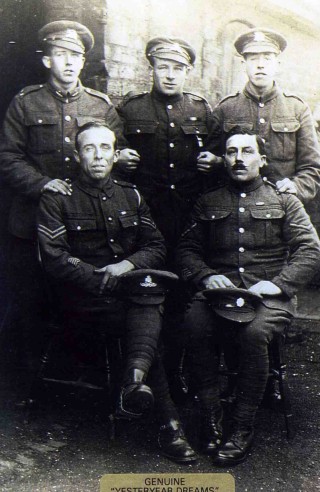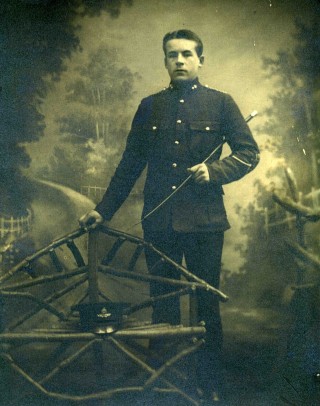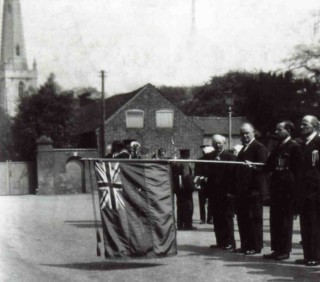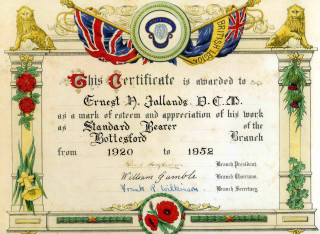The Jallands family in the 1st and 2nd World Wars
A Bottesford family in wartime
Two world wars forged the pattern of community and family life during the first half of the 20th century. The Bottesford war memorials in St Mary’s Church record sacrifice and service of those killed in action. The memory of life on the ‘Home Front’ is less visible. The following fragment from the Bottesford Parish Magazine for October 1915 provides insight into the ways that war touched the community and families. Children are mobilised to gather in the harvest, collections of money and food made in aid of military hospitals, volunteers recruited (this being before the introduction of conscription in 1916), letters home report the nature of modern warfare, injuries are reported and bravery acknowledged.
Five of Mrs Jallands’ sons served in the armed forces during WW1. All five sons were to survive the war. Two members of the Jallands family are mentioned – the brothers Herbert and Ernest. Ernest Jallands received two gallantry awards and returned to play a very active part in the British Legion, notably as the standard bearer from 1920 until 1952.
Service Biographies
The service biographies for each of these men can be found via the following links:
Albert Jallands (to be added)
The Home Front – 1st World War
Bottesford Parish Magazine October 1915 – NOTES FOR THE MONTH
According to instructions from the County Education Office, the Day School mid-summer holidays were so arranged that scholars might assist with the harvest. A week’s holiday (September 27th – October 4th) will also be given for potato-picking and fruit-gathering.
Mr Allcock informs me that from the Bottesford Depot for this District, which includes Woolsthorpe and Stathern from February 4th to September 18th, 26,220 eggs and £32 4s. 5d in cash were collected for military hospitals.
An open-air recruiting meeting was held at the Bottesford Cross on the evening of Saturday, September 11th. F. Dean, H. Jallands, W. Slater and F Allcorn volunteered at the close of the meeting. More recruits are still hoped for.
The following extracts from letters, dated September 15th and 16th, from a Bottesford man, may be of interest to Bottesford people: –
‘This is now my third night in the first line, and I am getting almost used to the incessant ping of rifle bullets, and the dull thud of cannon. I wish you could see me now, lying on a wooden bed in my dug out, surrounded everywhere with sandbags, shells and rifle bullets. Night is like daytime here, and all officers are on duty in turn for three hours, which are spent in continually patrolling up and down the trenches to see the sentries are on the alert. Sniping and machine-gun fire goes on all night, mostly directed against working parties, gun-fire is restricted to the daytime. Our right-half battalion was badly targeted during the day, but escaped scot-free. Our company mess-room is a cellar of a house which forms part of our line. It has been much bombarded, and the cellar is the only room with a roof to it, also having no windows, it can show no light at night. Two snipers live in the wooden framework, which is all that remains of the roof, and, as a result it attracts many shots. I had rather a thrilling time last night, when I took out a party to reconnoitre the grass between our trenches and the Germans, who are not more than 75 yards away. We crept out on our hands and knees through a tunnel, and I then spent an hour crawling over masses of barbed wire and rattling tin cans. I came back with my clothes torn and covered in mud, but without being hit. Whenever the Germans send up a flare light, one has to lie flat down and keep still for fear of snipers, and if you happen to be lying on a piece of barbed wire at the time, it is not very comfortable. There were also two unpleasant moments, when I saw a rifle pointed at me from our own trench only 20 yards away, and had to shout to stop him firing: and when I could not find the entrance of the tunnel! I saw a German aeroplane brought down by machine-gun fire three days ago, and there is nearly always an aeroplane being fired at by shrapnel.’
Our warm congratulations are given to Driver Ernest Henry Jallands, R.F.A., whose name appears in the newspapers as being entitled to a D.C.M. (Distinguished Conduct Medal) and also to the Russian decoration of the Cross of St. George (Third Class). He writes from Manchester, where he is in hospital, wounded:
“I wish all the Bottesford boys the best of luck, and hope that some of them may be able to bring more honours to the old village: though when I did the deeds that brought me these honours, I didn’t (think) of winning praise, but I saw that it was my duty, and I know anyone else would have done the same.”
Bottesford is proud of her son, and we all wish him a complete and speedy recovery. Mr. and Mrs. Jallands have five sons and one son-in-law now serving with the colours, and we congratulate them on this splendid record.
We regret to hear that Private Arthur Geeson has been seriously wounded, and is now in a hospital in France, and should like to express our sympathy with him family in their anxiety.
Cottage Meetings, the Young Men’s Bible Class, the Band af Hope and Meetings af the G.F.S. and Mothers’ Union will be resumed after the Harvest Festival, and will be announced in due course.
MARRIAGE
August 2. Harold J. Brassley, of London to Ethel Kathleen Allen.
BURIAL
August 25. John W. Blore, aged 48.
It is likely that Canon Vincent-Jackson authored the Parish Magazine. Perhaps the letter from the front was from his own son, Montagu, who was a Lieutenant with the Sherwood Foresters. He was killed in action on the 2nd February 1916 undertaking a similar reconnaissance to the one described above. His loss is recorded on the War Memorial in St Mary’s Church.
The Parish Magazine is reproduced courtesy of the “Yesteryear Dreams” Private Collection of Mr & Mrs G. Waudby.
We can work out that this photograph must have been taken sometime after September 11th 1915 – the date that Herbert volunteered at the Saturday evening recruitment meeting by the Bottesford Cross.
Some two decades after the Armistice the Jallands family, like many others, would once more be called to active service and war effort.
Mr George Waudby, has kindly written the following reminiscence of a “Bottesford Family at War – 1939/45” describing how the family members in the photograph above contributed to the war effort.
After the trials and tribulations of the 1st World War the cost of supporting the war effort during 2nd World War was demanding and for some of the village population the price was supreme. To the few, who may have been relative, school mate or friend but who did not return, we should take the occasional moment in thought.
The Ernest Jallands family, like many, were once again expected to rally to the colours, be it for Bottesford, or King and Country. Here is a brief record of just one average village family cast into war for the second time.
Mr Ernest Jallands, DCM (front row 1st left) enlisted with Major Wright of Bottesford and joined a contingent of British legion members who set sail for Poland. The German Army was to move swiftly into that country, dive bombing along the Polish Corridor. This along with other factors quickly called for the project to be abandoned. Returning home, Mr Jallands, due to age and disability, worked in an armament factory for the duration of the war. In the early years of the 2nd World War it was a requirement for all men to join an auxillary service, e.g., Home Guard, Fire Watch, First Aid and the Observer Corps. Mr Jallands enlisted in the latter, their duty post being a wood hut and raised platform on the top of Palmer’s Hill off the Normanton Road. Their objective was to keep a look out in the night sky, listen and try to locate enemy aircraft in flight. This was by engine sound or silhouette, estimated type, speed, numbers and flight path. This information was relayed by telephone to a national data centre. Mr Jallands duty roster being four hours each night, two nights a week. This duty was in addition to his work in the armament factory.
Mrs Mable Jallands (front row 2nd left) worked on the local farms in fields around Easthorpe for the duration of the war.
Daughter – Mrs Eileen Waudby (front row 3rd left). Eileen worked as an assistant at A. Chambers & Co of Grantham during the war. She is now the last surviving member of Mr and Mrs Jallands immediate family.
Son – Bernard Jallands (middle row left, leaning forward) served in the Royal Air Force during the war and saw active service in North Africa. He and his brother Ernest were lucky enough to meet up in this theatre of war.
Son – Albert Jallands (back row 1st left) was to serve on the Lincolnshire Regiment on active service in Iceland, Norway and Germany and was wounded during that period.
Daughter-in-law – Evelyn Jallands (back row 2nd left) Albert’s wife, worked in a munition factory.
Daughter-in-law – Gertrude Jallands (back row 3rd left) Bernard’s wife, also worked in an armaments factory.
Son-in-law – George Waudby (back row 4th left) Eileen’s husband, served in the army in the Royal Electrical and Mechanical Engineers. I saw active service in Burma at Kohima and Imphal. My tour of duty in that theatre lasted four years.
Son – Ernest Jallands (back row far right). The eldest son of the family. He also saw active service in North Africa.
Daughter-in-law – Elodie Jallands (middle row 2nd right) Ernest’s wife.
As just one family we all returned home safely. It is true to say, for all, it was a lucky run, and yes, a duty done. (George Waudby, October 2008)
We are grateful to the Jallands family for making available family photographs and other material documenting their war-time experience. All other data and records are taken from the “Yesteryear Dreams Collection” of Mr and Mrs G Waudby.


















Comments about this page
Here is some background info about the Jallands brothers.
1)Herbert, as mentioned above volunteered on 11/9/1915 and joined the Leicester regiment as private 21169. He transferred to the Labour Corps as private 469504. There is no record that he served overseas and the fact that he transferred to the LC suggests that he was not 100% fit to serve in a theatre of war. He was entitled to the British War and Victory Medals.
2. Albert, 2964 and later 240873 a private in the Leicester regiment. Entitled to the British War and Victory Medals. Again there is no record that he served overseas but the full service records of Albert and Herbert did not survive the blitz in WW2.
3. Ernest, was a pre war territorial in 5th Reserve Brigade Royal Field Artillery. War was declared on 4/8/1914 and Ernest was in France as part of the BEF with 14 Brigade Royal Field Artillery by 23/8/1914. He was Driver 65251 and as stated won the Distinguished Conduct Medal for his actions on 30/4/1915 and 2/5/1915. He was later promoted to sergeant.
4. Walter, has the good fortune in as much that his service records have survived. He enlisted on 5/10/1914 into the Notts Battery (Reserve) Royal Horse Artillery. He was 27 years and 306 days old, stood 5′ 7 1/4″ tall and weighed 152lbs. He sailed for Egypt on 9/4/1915 arriving on the 25/4/1915. He served with 19th Bde. RHA. and joine the MEF on 24/9/1915 and the Western frontier Force on 19/11/1915. Promoted to Bombadier (L/cpl) on 5/5/1916 and to corporal on 21/8/1916. He was promoted first to acting sergeant and then to sergeant on 17/4/1917 and 28/6/1917 respectively. Both promotions being made in the field. Surprisingly and at his own request he was demoted back to gunner on 11/4/1918. An officer, Lt. N E T Hodgson has signed his request to be demoted confirming that the demotion was not as a result of a court martial. Walter was transferred to 19 Bde HQ staff on 17/6/1918 and promoted once again to corporal on 1/7/1918 before finally being shipped home from Egypt and demobbed on 10/4/1919. His demob papers state that he was a sober, reliable and intelligent man, good with horses and handles men well in command. He was entitled to the British War and Victory medals and a 1915 Star.
5. There are well over 400 Arthur Wards listed in the MIC section and therefore, without further info as to his regiment I can not easily track him down.
6. Arthur Geeson who is noted as wounded in the parish magazine of October 1915 was private 2842 The Leicester Regiment. He went to France on 29/6/1915 and was discharged due to his wounds on 13/7/1916. He was entitled to the British War and Victory Medal, the 1915 Star and the Silver War Badge (wounds).
7. I have a gut feeling that the photo of the Jallands boys with Arthur Ward was taken post April 1919 when they were all safely home. Walter has his corporal’s tapes on his arm, which is the rank that he finished the war and in Sept 1915 when Herbert volunteered, Walter was already in Egypt. Neither Herbert nor Albert are at this time wearing any medal ribbons and it is not possible to see if Ernest has his sergeants stripes on. Both Walter and Arthur have their Long Service tapes on their right forearms
8. Finally, it is almost certain that the account of life at the front would come from MJ Vincent-Jackson to his father. The deed of leading fighting patrol into no mans land was always the job of a young subaltern and his platoon and it was on one such patrol that Lt. MJ Vincent-Jackson lost his life in February 1916.
Many thanks for these most interesting and detailed additions to this page.
In hindsight, I may be doing Herbert and Albert a disservice by suggesting that they did not serve overseas. Although their MICs do not mention overseas service, i recollect that to get an MIC in the first place you did have to serve abroad.
I have further information on Arthur Ward if it is of any interest to Jonathan. He served with the RASC as a driver. His service number was T4/061464. According to his medal records he received The Victory, British and Star medals and I have these. I know he served in Egypt but although I have scoured the National Archive records I’m afraid they must have been destroyed.
Re Montagu Vincent Jackson. My grandfather Cpl Albert Jackson (no relation ) was with M V J and 2 privates on patrol in no mans land at Bullecourt on 05/02.1916 when MVJ was fatally wounded. My grandfather in attempting to save him was also wounded and was later awarded the MM.
Many thanks for this most interesting information. If you have any further details, photographs etc that you might wish to add to the site please do get in touch again. We could easily add them to MVP Jackson’s page or set up a page with details of your grandfather’s connection to MV Jackson.
Add a comment about this page